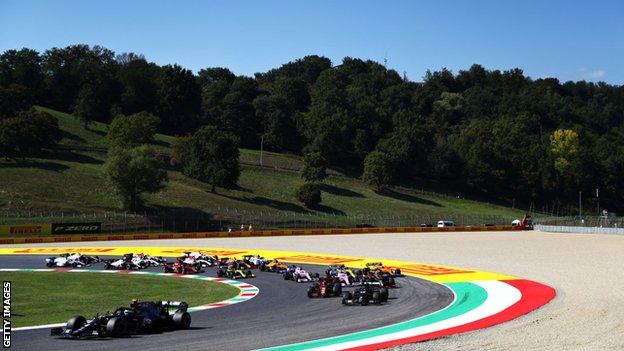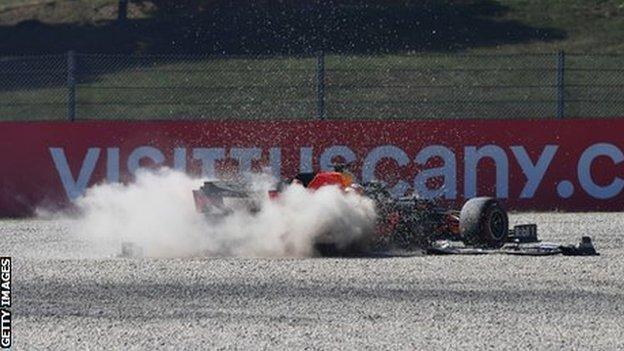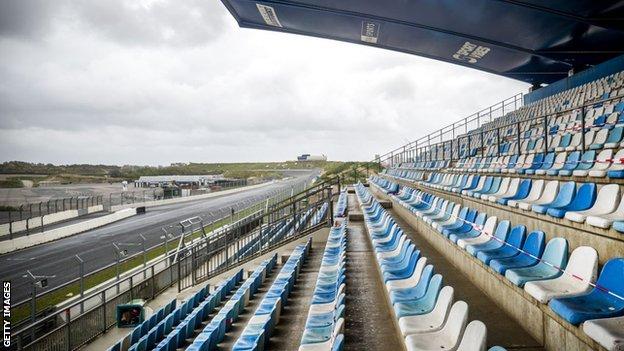
Former F1 driver Jolyon Palmer, who left Renault during the 2017 season, is part of the BBC team and offers insight and analysis from the point of view of the competitors.
The Tuscan Grand Prix was a reminder of the benefits of a good old-fashioned classic circuit, as Lewis Hamilton triumphed in a chaotic, action-packed, incident-strewn race.
It kept Formula 1’s positive momentum with back-to-back exciting races over two weekends in Italy.
Mugello was making its debut as an F1 race venue last weekend, but the circuit was built in 1974 and has kept its original layout. That gives it an old-school feel of fast, flowing corners and punishing run-off areas.
Essentially, it’s not a circuit that’s designed for F1. Mugello is a major venue in bike racing and Monza is the home of cars in Italy. But Mugello needed little tinkering to make it acceptable to 21st Century F1.
Its age, and the fact it was new to F1, meant there were no asphalt run-offs, which plague pretty much every permanent grand prix venue. And while it remains up to FIA grade 1 safety specification – required to host F1 – the walls seem relatively close in some of the faster corners as well.
An antidote to modern sterility
All this means it is the opposite of the modern F1 circuits, many of which are known as ‘Tilke-dromes’ after the man who designed tracks such as Shanghai, Bahrain and Sochi.
Each of Hermann Tilke’s circuits has some individual defining features but they mostly have very similar characteristics and overall feel – notably with slow corners on to a whopping long straight into a slow corner.
This has been deemed the modern standard of building an F1 track, because it has been perceived as the best way of creating overtaking, by providing high speeds into good out-braking opportunities.
Yet I suspect no Tilke design would make any driver’s list of favourite circuits. They would always picks places such as Spa, Silverstone, Monaco and Suzuka. Classic, flowing tracks – like Mugello.
It was a circuit that defied all the Tilke design theories and yet provided a great spectacle in the traditional sense.
The drivers loved it. It’s a super-fast, flowing circuit with the middle sector comprising some flat-out corners that require serious bravery and commitment. Most drivers were never dropping below fourth gear around the entire lap in qualifying, which makes it unique on the F1 calendar.

Its layout led to questions as to how hard overtaking might be come race day. But as the Grand Prix progressed, it became clear that drivers could overtake, with numerous moves being done into Turn One.
In truth, the first corner was the only legitimate overtaking place on the circuit and some doubters will say that in itself is a problem. But actually it is fairly well the norm for most tracks these days, because overtaking in F1 is just so difficult across the board with the current cars.
The Italian Grand Prix at Monza the previous weekend highlighted this, with no legitimate overtakes after the first lap of either start.
We are used to somewhat processional races at circuits like Budapest and Barcelona, which also don’t have more than one conventional overtaking place.
And with the modern rules and regulations, even historically epic circuits like Spa become a one-trick pony as drivers always wait for the Kemmel Straight to make their moves with the help of the DRS overtaking aid. And actually this year there was not an awful lot of passing in the Belgian Grand Prix either.
So Mugello not only stood up to the more conventional F1 venues in terms of overtaking but it actually surpassed many of them, with some great overtaking action down at Turn One from the likes of Alex Albon, Lando Norris and Daniel Ricciardo.
A track that can, and did, bite
But where Mugello really stood out as a venue was in its punishing nature, which came as no surprise given the combination of fast corners and gravel run-offs.
On top of that, it was a new circuit to most drivers, which adds an extra random element into the mix as there is a real shortage of historical data for drivers to study.
This was evident from Friday practice onwards. Norris spat his McLaren into the wall on the exit of Turn Three, in what might be the first crash I’ve seen from the young Briton in his short F1 career. A rare mistake was punished and Norris brought out the weekend’s first red flag in second practice.
The next day, Esteban Ocon disrupted the final qualifying runs with a wild spin coming out of Turn Five in his Renault and narrowly avoided hitting the wall. He did, however, possibly impact the result of qualifying as many drivers behind couldn’t improve. Importantly, these included Valtteri Bottas, who reckoned he could have beaten Hamilton to pole position otherwise.
But then Sunday saw the real drama, with a safety car and two red flags underlining the carnage that ensued.
There were incidents from the very start. At the third corner of racing, Carlos Sainz spun his McLaren and Monza winner Pierre Gasly tangled with Romain Grosjean and Kimi Raikkonen – who barrelled into the back of Max Verstappen and beached the Dutchman and Gasly into the gravel, instigating a safety-car period.

On many modern circuits, the drivers might have been able to limp back to the pits, rejoining from asphalt run-offs. But Verstappen spun his wheels to get going which just dug him deeper into the gravel – a familiar sight from the past, but a rare thing indeed in F1 these days.
A safety-car re-start always has the potential for overtaking, incident or chaos, but so often they are becoming more routine – not in Mugello.
A combination of a number of factors led to the big pile-up at the restart: the FIA putting the safety car lights out late – preventing Bottas from building a gap; the Finn then doing the sensible thing in his position and holding everyone until the last moment, with the long Mugello straight at the forefront of his mind; and some over-opportunistic drivers behind trying to predict when Bottas would go.
That led to the first red flag, which was not really the circuit’s doing. The long start-finish straight certainly contributed to events, but a similar thing could have happened at other circuits with similar straights, such as Interlagos or Baku.
However, Mugello’s high-speed nature did contribute to the second incident which caused a red flag later on.
Lance Stroll seemed to have a left-rear tyre failure on his Racing Point, which pitched him hard into the wall heading into the second Arrabbiata – a flat-out, 170mph corner – and brought out the day’s second red flag. The barriers needed repairing and Stroll’s then-smouldering car needed removing through a tight spot in the barriers.
While red-flag delays can be frustrating for viewers, the new adoption of a standing re-start can certainly add drama, as demonstrated in both the last two events.
The start is so often the most exciting part of a Grand Prix, and the Tuscan race had three of them, the first two of which ultimately decided the race at the front as well.
Crashes lead to surprises
Attrition turned some of the old F1 races of the previous century into thrillers, and with just 12 cars left by the flag in Mugello, there was every chance of some nice underdog stories.
Ricciardo almost won Renault a first podium since their comeback five years ago before being passed by Albon’s Red Bull. And George Russell was unfortunate not to collect his first points in a Williams. The race did, though, yield an overdue maiden podium for Albon, and first points of the season for Raikkonen.
None of this is to say that Mugello is the perfect F1 venue or that the Tuscan Grand Prix was one of the best I’ve ever watched.
But it was certainly an enjoyable weekend for all parties and a circuit which seemed to please both the drivers in terms of driving exhilaration and fans in terms of entertainment, which is not always an easy combination to achieve.
It was a nice change to have a new F1 venue which wasn’t a Tilke-drome or a ‘car park circuit’ like Paul Ricard, and the very nature of this old-school circuit contributed a lot to an entertaining weekend.
Of course it’s only Covid-19 that has meant F1 was racing at Mugello at all. But in a year that has been full of gloom and depression, the mix-up to the calendar has been one of the few benefits F1 fans can enjoy this year.
Zandvoort in Holland, another classic, old-school track, was meant to be on the calendar in 2020 and seems to have similar characteristics to Mugello. So I’m sure their race organisers were pleased to see the Tuscan Grand Prix be successful before the return of the Dutch Grand Prix next year.

If F1 were to go back and race at Mugello in the future perhaps some of the intrigue and errors would be reduced, as teams and drivers can learn from their mistakes of this race.
But as it was, the unpredictability and the move to a properly untouched classic circuit was a nice change from the norm and spiced up the action immeasurably.
Who knows, perhaps it will even give F1 some food for thought.


